Table of contents
- About centrifugal forces, three phases of a curve and the Kamm’s circle Basics: lateral and circumferential forces when riding a motorcycle
- Circumferential and centrifugal force
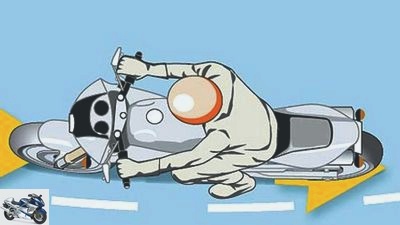
archive
counselor
technology & future
Lateral and circumferential forces when riding a motorcycle – driving physics when riding a motorcycle
About centrifugal forces, three phases of a curve and the Kamm’s circle
Basics: lateral and circumferential forces when riding a motorcycle
Wherever great forces are at work, it has to keep the bike in line: a tire should implement decelerations and accelerations, and also defy centrifugal force. But which forces are involved and how does it work? Here are the answers.
Manuel Fuchs
10/10/2011
Circumferential and centrifugal force
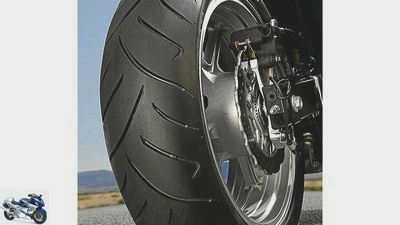
archive
Dunlop Roadsmart.
The magical one “Grip” only comes into play at the very end of this story. First, we take care of the forces that the two tires, as the only connections between the motorcycle and the road, have to withstand: When the driver accelerates, the engine picks up speed and pulls the chain on the rear wheel, the tire transfers a force to the tire via its contact patch Street that acts in the direction of its perimeter – hence the name Circumferential force – and the motorcycle accelerates.
Circumferential forces are marked in yellow here. Braking forces are also circumferential forces, but counteract the acceleration. This affects the motorcycle when cornering Centrifugal force (Centrifugal force) that it wants to carry out of the curve. To prevent this from happening, the tires are challenged again: They apply cornering forces (each marked in blue) that are just as large as the centrifugal force and counteract it.
In this way, the motorcycle stays on track and is not carried out of the curve. The higher the speed, the tighter the curve and the heavier the motorcycle, the higher the centrifugal force and the more cornering force the tires have to provide.
And why should these automatisms even interest the driver? Quite simply: He is responsible for ensuring that the forces do not overwhelm the tire. Overstrained tires spin or slip – with sometimes ugly consequences.
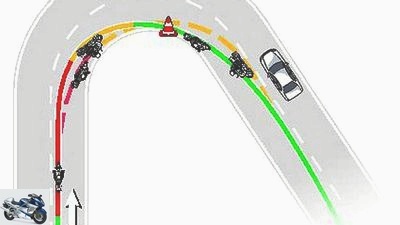
archive
When braking on straight route (A) the circumferential forces are high, the cornering forces zero. When entering the Curve (B) the lateral forces grow; the driver keeps the rear wheel slightly under tension.
From the apex of the driven line, the driver straightens the motorcycle up again and accelerates (C): The lateral forces decrease, the circumferential forces increase.
Braking and turning:
Most motorcyclists use the front brake to slow down; accordingly, circumferential forces act primarily on the front tire before a curve. From the moment you turn in, centrifugal and cornering forces occur.
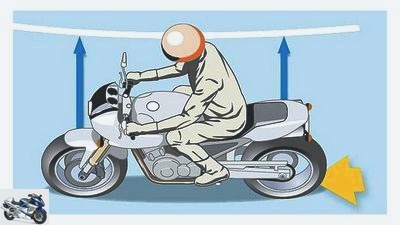
archive
Cornering.
Cornering: In an inclined position, the lateral forces that keep the motorcycle on track predominate. Slight acceleration stabilizes the motorcycle, and low circumferential forces then act on the rear wheel.
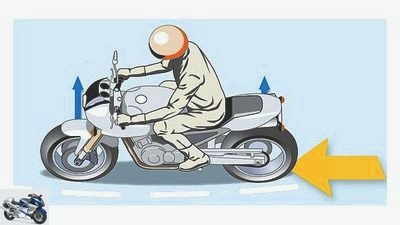
archive
Stand up and accelerate.
Righting up and accelerating: At the exit of the curve, the radius driven and consequently the cornering force decrease. The motorcycle accelerates; circumferential forces act on the rear wheel.
The area that a normal motorcycle rear tire has available to implement all the circumferential and lateral forces is hardly larger than the back of a hand, and not even half the size of a postcard. Surface wear, incorrect air pressure, moisture and traces of oil make this task unnecessarily difficult.
So: check regularly to see how the rubber is doing. He will thank you with reliable power transmission.
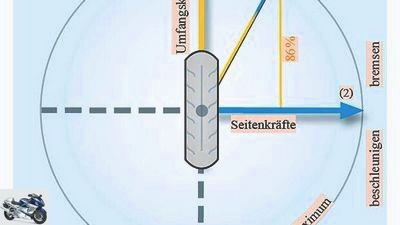
archive
Circumferential forces act in the rolling direction of the tire. Cornering forces counteract the centrifugal force in the direction of the inside of the curve.
No tire story without the Kamm circle: It describes the grip limit of a tire as a function of the forces acting. If a power arrow ends within the circle, there is liability; outside the tire slips away.
If a motorcycle is decelerated or accelerated in the absolute limit range, the tires must call up all circumferential forces. Every degree of inclination would now provoke a slide (1). Also the other way around: In a maximum lean angle, a braking or acceleration maneuver would allow the tire to be lubricated (2).
The area in between is more interesting: If a tire requires 50 percent of its possible lateral forces, it can also transfer 86 percent of its possible circumferential forces at the same time (3). The size of the circle, i.e. the total force a tire can transmit, is determined by external factors – primarily the coefficient of friction between the rubber and the road surface: on cobblestones it is only about half as high as on normal country road asphalt, on ice it is less than a tenth from that.
Wetness, dirt, leaves, lane markings and combinations thereof make the circle smaller and require the driver to be more careful. So that the tire is not overwhelmed.
Related articles
-
Technique: lateral and circumferential forces
Artist counselor workshop Technique: lateral and circumferential forces Technique: lateral and circumferential forces The physics of motorcycling Even if…
-
Driving physics of the motorcycle tire Kammscher Kreis
Illustration: Muller counselor Driving experience & Driving tips Driving physics of the motorcycle tire Kammscher Kreis The Kamm circle Physical basics…
-
Technology PS driving dynamics cornering ABS
markus-jahn.com 18th pictures markus-jahn.com 1/18 … as well as in the city to its limits. markus-jahn.com 2/18 On the one hand, this smooth transition…
-
The right tire choice for a motorcycle
Markus Jahn 26th pictures MOTORCYCLE 1/26 On the way on alpine passes? That’s how it works! MOTORCYCLE 2/26 Seductive winding curves with risk. The…
-
Driving tips and advice on motorcycling
fact 26th pictures MOTORCYCLE 1/26 On the way on alpine passes? That’s how it works! MOTORCYCLE 2/26 Seductive winding curves with risk. The course of…
-
Driving tips: Warm up the motorcycle properly
jkuenstle.de counselor workshop Driving tips: Warm up the motorcycle properly This is how it works: Warm up the motorcycle properly How to get your bike…
-
Technology: Driving dynamics safety
counselor technology & future Technology: driving dynamics / safety Technology: driving dynamics / safety Subject focus The discussion at the motorcycle…
-
Correct cornering with the motorcycle
Jahn 28 pictures Kawasaki 1/28 Curves are the icing on the cake for motorcyclists. Without them, life on two wheels would be bland. Muller 2/28 3. Green…
-
Braking properly with the motorcycle
Jahn counselor Driving experience & Driving tips Braking properly with the motorcycle Brake properly Braking with and without ABS Motorcycles ride well…
-
The fascination of cornering on a motorcycle
Werel Sports & scene Motorsport The fascination of cornering on a motorcycle The fascination of cornering on a motorcycle And the curve beckons forever…